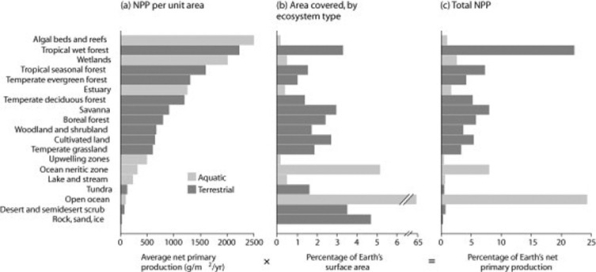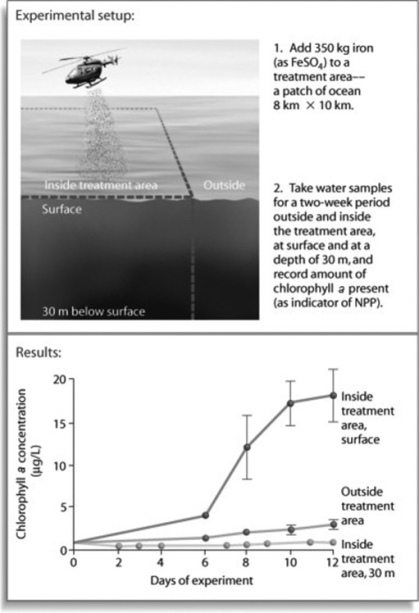A) restore the physical structure
B) restore native species that have been extirpated due to disturbance
C) remove competitive invasive species
D) remove toxic pollutants
F) B) and C)
Correct Answer

verified
Correct Answer
verified
Multiple Choice
Why does a vegetarian leave a smaller ecological footprint than an omnivore?
A) Fewer animals are slaughtered for human consumption.
B) There is an excess of plant biomass in all terrestrial ecosystems.
C) Vegetarians need to ingest less chemical energy than omnivores.
D) Eating meat is an inefficient way of acquiring photosynthetic productivity.
F) B) and D)
Correct Answer

verified
Correct Answer
verified
Multiple Choice
If you applied a fungicide to a cornfield, what would you expect to happen to the rate of decomposition and net ecosystem production (NEP) ?
A) Both decomposition rate and NEP would decrease.
B) Neither would change.
C) Decomposition rate would increase and NEP would decrease.
D) Decomposition rate would decrease and NEP would increase.
F) A) and C)
Correct Answer

verified
Correct Answer
verified
Multiple Choice
Use the following figure to answer the question.
 After looking at the figure, what can be said about productivity in this ecosystem?
After looking at the figure, what can be said about productivity in this ecosystem?
A) Nothing can be said based on this information.
B) Between 80% and 90% of the energy is lost between most trophic levels.
C) Between 10% and 20% of the energy is lost between most trophic levels.
D) Productivity increases with each trophic level.
F) All of the above
Correct Answer

verified
Correct Answer
verified
Multiple Choice
Which statement best describes what ultimately happens to the chemical energy that is consumed but not used to produce new biomass in the process of energy transfer between trophic levels in an ecosystem?
A) It is undigested and winds up in the feces and is not passed on to higher trophic levels.
B) It is used by organisms to maintain their life processes through the reactions of cellular respiration.
C) Heat produced by cellular respiration is used by heterotrophs for thermoregulation.
D) It is eliminated as feces or is dissipated into space as heat as a result of cellular respiration consistent with the second law of thermodynamics.
F) None of the above
Correct Answer

verified
Correct Answer
verified
Multiple Choice
Which of the following ecosystems would likely have the largest net primary productivity per hectare and why?
A) open ocean, because of the total biomass of photosynthetic autotrophs
B) grassland, because of rapid growth, the small standing crop biomass that results from consumption by herbivores, and rapid decomposition
C) tundra, because of the incredibly rapid period of growth during the summer season
D) deep ocean, due to the high activity of chemoautotrophs at deep sea vents
F) All of the above
Correct Answer

verified
Correct Answer
verified
Multiple Choice
How does inefficient transfer of energy among trophic levels result in the typically high endangerment status of many top-level predators?
A) Top-level predators are destined to have small populations that are sparsely distributed.
B) Predators have relatively large population sizes.
C) Predators are more disease-prone than animals at lower trophic levels.
D) Top-level predators are more likely to be stricken with parasites.
F) A) and B)
Correct Answer

verified
Correct Answer
verified
Multiple Choice
Use the following figure to answer the question.
 Which habitat type in the figure makes available the most new tissue to consumers?
Which habitat type in the figure makes available the most new tissue to consumers?
A) tropical wet forest
B) open ocean
C) algal beds and reefs
D) wetlands
F) A) and D)
Correct Answer

verified
Correct Answer
verified
Multiple Choice
Why is terrestrial productivity higher in equatorial climates?
A) Productivity increases with temperature.
B) Productivity increases with water availability.
C) Productivity increases with available sunlight.
D) The answer is most likely a combination of the other responses.
F) None of the above
Correct Answer

verified
Correct Answer
verified
Multiple Choice
Nitrifying bacteria participate in the nitrogen cycle mainly by ________.
A) converting nitrogen gas to ammonia
B) releasing ammonium from organic compounds, thus returning it to the soil
C) converting ammonium to nitrate, which plants absorb
D) incorporating nitrogen into amino acids and organic compounds
F) C) and D)
Correct Answer

verified
Correct Answer
verified
Multiple Choice
Use the following figure to answer the question.
 What treatment results that were presumably part of the experimental design are not fully depicted in the graph?
What treatment results that were presumably part of the experimental design are not fully depicted in the graph?
A) Chlorophyll a concentration at 30 m depth within the treatment area
B) Chlorophyll a concentration at the surface within the treatment area
C) An indicator of net primary production in the treatment area at the surface and at 30 m deep
D) An indicator of net primary production outside the treatment area at depth and at 30 m deep
F) B) and C)
Correct Answer

verified
Correct Answer
verified
Multiple Choice
Which of the following organisms is correctly paired with its trophic level?
A) cyanobacterium-primary consumer
B) grasshopper-secondary consumer
C) phytoplankton-primary producer
D) fungus-primary consumer
F) A) and C)
Correct Answer

verified
Correct Answer
verified
Multiple Choice
Why do logged tropical rain forest soils typically have nutrient-poor soils?
A) Tropical bedrock contains little phosphorous.
B) Logging results in soil temperatures that are lethal to nitrogen-fixing bacteria.
C) Most of the nutrients in the ecosystem are removed in the harvested timber.
D) The cation exchange capacity of the soil is reversed as a result of logging.
F) B) and C)
Correct Answer

verified
Correct Answer
verified
Multiple Choice
Which of these ecosystems has the lowest net primary production per square meter?
A) a salt marsh
B) an open ocean
C) a coral reef
D) a tropical rain forest
F) A) and B)
Correct Answer

verified
Correct Answer
verified
Multiple Choice
Why is it that satellites, using wavelength reflectance technology, detect variable levels of productivity across Earth's oceans, rather than an increase toward the equator?
A) Temperatures at the equator often exceed those which are optimal for primary production.
B) Light at the equator is too constant and direct.
C) NPP in Earth's open oceans could differ due to variability in depth, the presence of coral reefs, or by ocean currents.
D) Satellites detect differences by measuring the amount of water vapor emitted by transpiring producers, and this is a variable measurement in the oceans.
F) All of the above
Correct Answer

verified
Correct Answer
verified
Multiple Choice
Which of the following is an accurate statement regarding mineral nutrients in soils and their implication for primary productivity?
A) Globally, phosphorous availability is most limiting to primary productivity.
B) Adding a nonlimiting nutrient will stimulate primary productivity.
C) Phosphorous is sometimes unavailable to producers due to leaching.
D) Alkaline soils are more productive than acidic soils.
F) C) and D)
Correct Answer

verified
Correct Answer
verified
Multiple Choice
Use the following figure to answer the question.
 On the diagram of the nitrogen cycle, which number represents the ammonium ion (NH₄⁺) ?
On the diagram of the nitrogen cycle, which number represents the ammonium ion (NH₄⁺) ?
A) 1
B) 2
C) 3
D) 4
F) C) and D)
Correct Answer

verified
Correct Answer
verified
Multiple Choice
Nitrifying bacteria participate in the nitrogen cycle mainly by
A) converting nitrogen gas to ammonia.
B) releasing ammonium from organic compounds, thus returning it to the soil.
C) converting ammonium to nitrate, which plants absorb.
D) incorporating nitrogen into amino acids and organic compounds.
F) A) and D)
Correct Answer

verified
Correct Answer
verified
Multiple Choice
Which of the following is primarily responsible for limiting the number of trophic levels in most ecosystems?
A) Many primary and higher-order consumers are opportunistic feeders.
B) Decomposers compete with higher-order consumers for nutrients and energy.
C) Nutrient cycling rates tend to be limited by decomposition.
D) Energy transfer between trophic levels is usually less than 20 percent efficient.
F) B) and C)
Correct Answer

verified
Correct Answer
verified
Multiple Choice
The Hubbard Brook watershed deforestation experiment revealed that ________. I.deforestation increased water runoff II.nitrate concentration in waters draining the deforested area became dangerously high III.calcium levels remained high in the soil of deforested areas
A) only I
B) only II
C) only III
D) only I and II
F) C) and D)
Correct Answer

verified
Correct Answer
verified
Showing 41 - 60 of 68
Related Exams